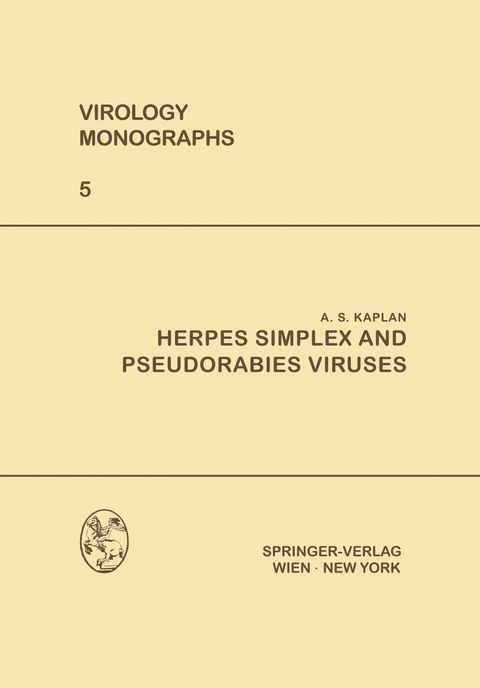
Herpes Simplex and Pseudorabies Viruses
Springer Wien (Verlag)
978-3-7091-8231-4 (ISBN)
I. Introduction.- II. History.- A. Herpes Simplex Virus.- B. Pseudorabies Virus.- III. Classification and Nomenclature.- IV. Properties of the Viruses.- A. Morphology.- B. Physical-chemical Structure.- C. Antigenic Structure.- D. Eesistance to Physical and Chemical Agents.- V. Cultivation.- A. Host Range.- B. Environmental Factors that Affect Virus Formation.- C. Virus Growth Cycle.- D. Plaque Formation.- VI. Cytopathogenicity.- A. Cross Cytopathology.- B. Intranuclear Alterations.- C. Chromosomal Alterations.- VII. Metabolism of Infected Cells.- A. Technical Problems in the Chemical Analysis of Cells Infected with the Herpes Viruses.- B. DNA Synthesis.- C. RNA Synthesis.- D. Protein Synthesis.- E. Site of Synthesis of Viral Components.- F. Virus Assembly.- G. Enzymology of the Virus-infected Cells.- H. Control of the Infective Process.- I. Molecular Viral Chemotherapy.- VIII. Abortive Infection.- IX. Pathogenesis.- A. Susceptible Animals.- B. Influence of the Age of Animals on Pathogenicity of Herpes Simplex and Pseudorabies Viruses.- C. Dynamics of Development of Disease.- X. Variation.- A. Virulence and Cytopathogenicity.- B. Conditional Lethal Mutants.- C. Drug-resistant Mutants.- XI. Immunity.- A. Active Immunization.- B. Passive Immunization.- C. Interference and Interferon.- XII. Essential Clinical Features.- A. Herpes Simplex Virus.- B. Pseudorabies Virus.- XIII. Pathology.- A. Herpes Simplex Virus.- B. Pseudorabies Virus.- XIV. Diagnosis.- A. Herpes Simplex Virus.- B. Pseudorabies Virus.- XV. Treatment.- XVI. Epidemiology.- A. Herpes Simplex Virus.- B. Pseudorabies Virus.- XVII. Latent and Persistent Virus.- XVIII. Abbreviations.- References.
| Erscheint lt. Verlag | 16.1.2012 |
|---|---|
| Reihe/Serie | Virology Monographs Die Virusforschung in Einzeldarstellungen |
| Zusatzinfo | IV, 118 p. |
| Verlagsort | Vienna |
| Sprache | englisch |
| Maße | 170 x 244 mm |
| Gewicht | 228 g |
| Themenwelt | Medizinische Fachgebiete ► Radiologie / Bildgebende Verfahren ► Nuklearmedizin |
| Schlagworte | Herpes simplex-Virus • Pseudowutvirus |
| ISBN-10 | 3-7091-8231-X / 370918231X |
| ISBN-13 | 978-3-7091-8231-4 / 9783709182314 |
| Zustand | Neuware |
| Haben Sie eine Frage zum Produkt? |
aus dem Bereich


